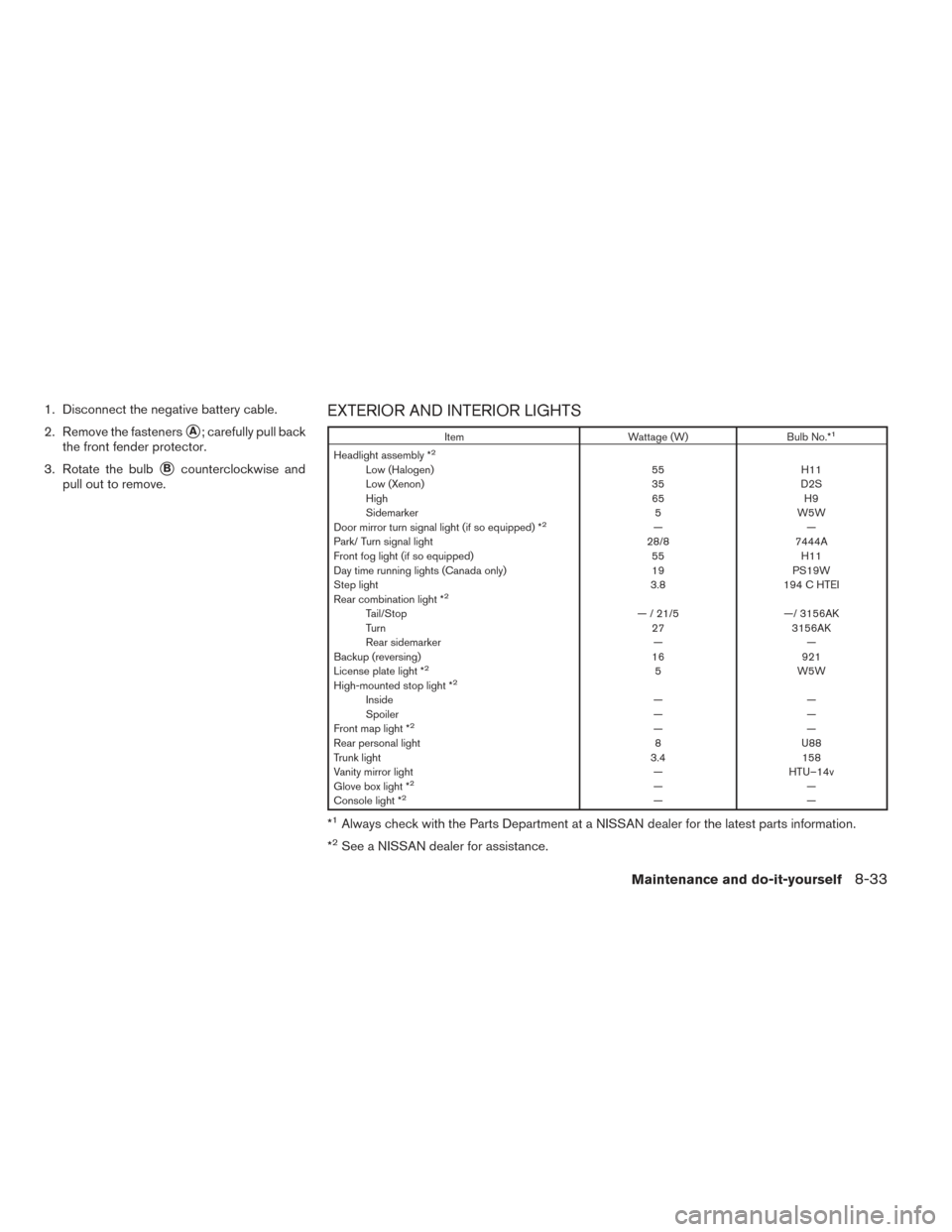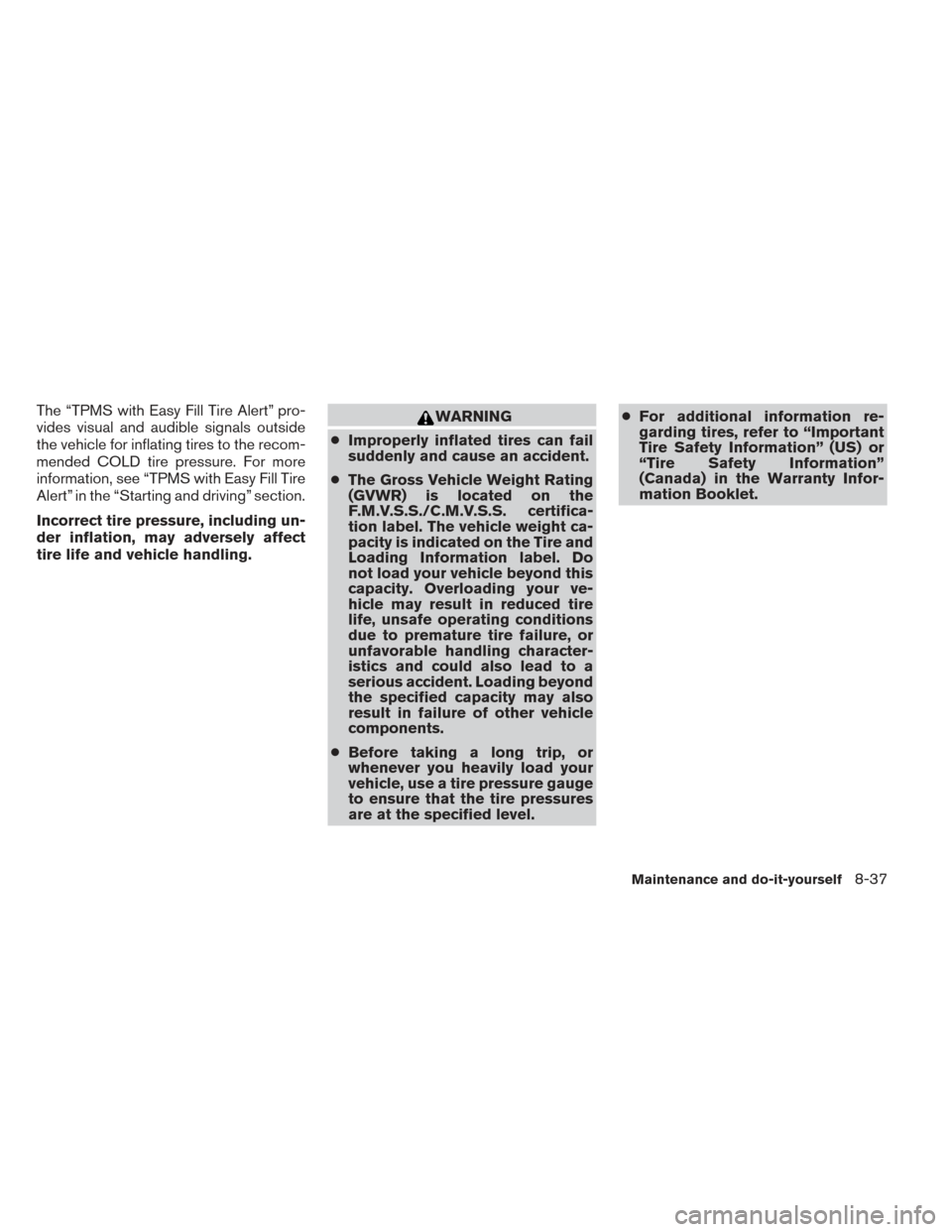Page 380 of 428
1. Disconnect the negative battery cable.
2. Remove the fasteners
�A; carefully pull back
the front fender protector .
3. Rotate the bulb
�Bcounterclockwise and
pull out to remove.
Reverse steps to install.
Maintenance and do-it-yourself8-31
Page 381 of 428
PARK/TURN SIGNAL LIGHTS
Replacing the park/turn signal bulb
LDI2137
8-32Maintenance and do-it-yourself
Page 382 of 428

1. Disconnect the negative battery cable.
2. Remove the fasteners
�A; carefully pull back
the front fender protector.
3. Rotate the bulb
�Bcounterclockwise and
pull out to remove.
EXTERIOR AND INTERIOR LIGHTS
Item Wattage (W)Bulb No.*1
Headlight assembly *2
Low (Halogen) 55H11
Low (Xenon) 35D2S
High 65H9
Sidemarker 5W5W
Door mirror turn signal light (if so equipped) *
2——
Park/ Turn signal light 28/87444A
Front fog light (if so equipped) 55H11
Day time running lights (Canada only) 19PS19W
Step light 3.8194 C HTEI
Rear combination light *
2
Tail/Stop — / 21/5—/ 3156AK
Turn 273156AK
Rear sidemarker ——
Backup (reversing) 16921
License plate light *
25 W5W
High-mounted stop light *2
Inside ——
Spoiler ——
Front map light *
2——
Rear personal light 8U88
Trunk light 3.4158
Vanity mirror light —HTU–14v
Glove box light *
2——
Console light *2——
*1Always check with the Parts Department at a NISSAN dealer for the latest parts information.
*
2See a NISSAN dealer for assistance.
Maintenance and do-it-yourself8-33
Page 383 of 428
1. Front map light
2. Headlamp assembly
3. Park/ Turn signal light
4. Fog light (if so equipped)/ Day timerunning light (Canada only)
5. Step light
6. Door mirror turn signal light
(if so equipped)
7. Personal light
8. High-mount stoplight
9. Trunk light
10. Spoiler-mount stop light
11. Rear combination light
12. License plate light
LDI2100
8-34Maintenance and do-it-yourself
Page 384 of 428
Replacement procedures
All other lights are either type A, B, C or D. When
replacing a bulb, first remove the lens, light
and/or cover.
Indicates bulb removal
Indicates bulb installationUse a cloth
�1to protect the housing.
Use a cloth�1to protect the housing.
Rear combination light
Bulb replacement requires the removal of the rear
combination light assembly. If replacement is re-
quired, see your NISSAN dealer.
WDI0306
Step light
LDI0341
Personal light
WDI0670
Maintenance and do-it-yourself8-35
Page 385 of 428

If you have a flat tire, see “Flat tire” in the
“In case of emergency” section of this
manual.
TIRE PRESSURE
Tire Pressure Monitoring System
(TPMS)
This vehicle is equipped with the Tire
Pressure Monitoring System (TPMS) . It
monitors tire pressure of all tires except
the spare. When the low tire pressure
warning light is lit and the “Tire Pressure
Low - Add Air” warning appears in the
vehicle information display, one or more of
your tires is significantly under-inflated.
The TPMS will activate only when the
vehicle is driven at speeds above 16 MPH
(25 km/h). Also, this system may not de-
tect a sudden drop in tire pressure (for
example a flat tire while driving) .
For more details, refer to “Low tire pres-
sure warning light” in the “Instruments and
controls” section, “Tire Pressure Monitor-
ing System (TPMS)” in the “Starting and
driving” section, and “Flat tire” in the “In
case of emergency” section.
Tire inflation pressure
Check the tire pressures (including the
spare) often and always prior to long dis-
tance trips. The recommended tire pres-
sure specifications are shown on the
F.M.V.S.S./C.M.V.S.S. certification label
or the Tire and Loading Information label
under the “Cold Tire Pressure” heading.
The Tire and Loading Information label is
affixed to the driver side center pillar. Tire
pressures should be checked regularly
because:● Most tires naturally lose air over time.
● Tires can lose air suddenly when
driven over potholes or other objects
or if the vehicle strikes a curb while
parking.
The tire pressures should be checked
when the tires are cold. The tires are
considered COLD after the vehicle has
been parked for 3 or more hours, or driven
less than 1 mile (1.6 km) at moderate
speeds.
Trunk light
LDI2135
WHEELS AND TIRES
8-36Maintenance and do-it-yourself
Page 386 of 428

The “TPMS with Easy Fill Tire Alert” pro-
vides visual and audible signals outside
the vehicle for inflating tires to the recom-
mended COLD tire pressure. For more
information, see “TPMS with Easy Fill Tire
Alert” in the “Starting and driving” section.
Incorrect tire pressure, including un-
der inflation, may adversely affect
tire life and vehicle handling.WARNING
● Improperly inflated tires can fail
suddenly and cause an accident.
● The Gross Vehicle Weight Rating
(GVWR) is located on the
F.M.V.S.S./C.M.V.S.S. certifica-
tion label. The vehicle weight ca-
pacity is indicated on the Tire and
Loading Information label. Do
not load your vehicle beyond this
capacity. Overloading your ve-
hicle may result in reduced tire
life, unsafe operating conditions
due to premature tire failure, or
unfavorable handling character-
istics and could also lead to a
serious accident. Loading beyond
the specified capacity may also
result in failure of other vehicle
components.
● Before taking a long trip, or
whenever you heavily load your
vehicle, use a tire pressure gauge
to ensure that the tire pressures
are at the specified level. ●
For additional information re-
garding tires, refer to “Important
Tire Safety Information” (US) or
“Tire Safety Information”
(Canada) in the Warranty Infor-
mation Booklet.
Maintenance and do-it-yourself8-37
Page 387 of 428
Tire and loading information label
�1Seating capacity: The maximum num-
ber of occupants that can be seated
in the vehicle.
�2Original tire size: The size of the tires
originally installed on the vehicle at
the factory.
�3Cold tire pressure: Inflate the tires to
this pressure when the tires are cold.
Tires are considered COLD after the
vehicle has been parked for 3 or more
hours, or driven less than 1 mile
(1.6 km) at moderate speeds. The
recommended cold tire inflation is set
by the manufacturer to provide the
best balance of tire wear, vehicle
handling, driveability, tire noise, etc.,
up to the vehicle’s GVWR.
�4Tire size – refer to “Tire labeling” later
in this section.
�5Spare tire size.
�6Vehicle load limit: See “Vehicle load-
ing information” in the “Technical and
consumer information” section.
LDI2083
8-38Maintenance and do-it-yourself